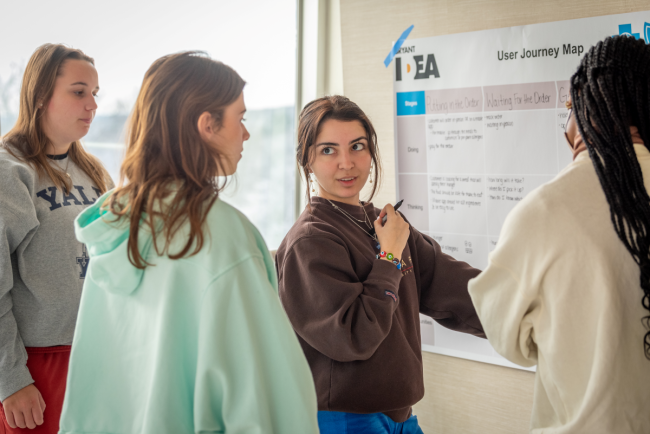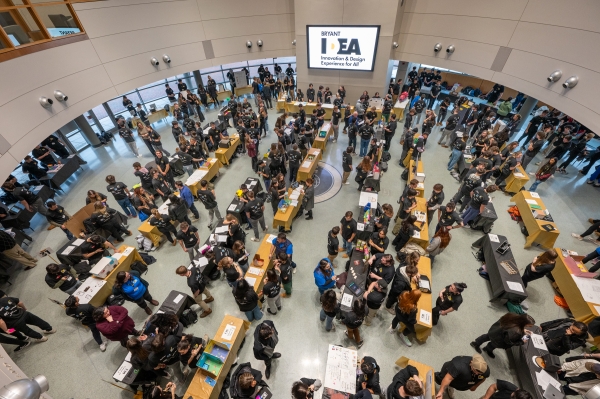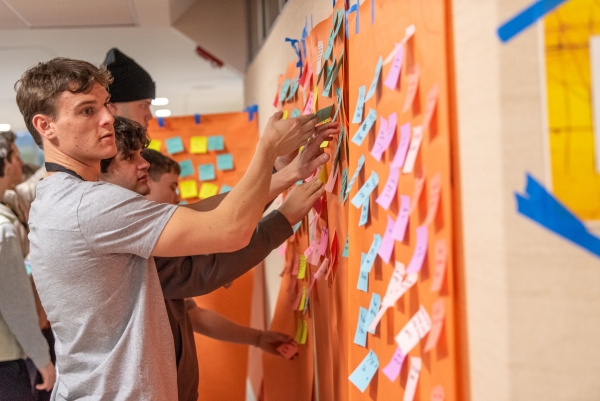You have /5 articles left.
Sign up for a free account or log in.

IDEA at Bryant University requires all first-year students to collaborate in small teams to tackle a real-world problem over 72 hours.
Bryant University
A winter 2023 Student Voice survey by Inside Higher Ed and College Pulse found a quarter of students believe developing skills relevant to any job or career is one of the most important outcomes of their academic career.
For the past decade, Bryant University, a private institution in Rhode Island, has offered first-year students the opportunity to participate in a three-day experiential learning course, working in small groups to tackle a real-life problem. IDEA, short for Innovation Design Experience for All, gives students a space to learn and apply design principles as well as learn from peers, alumni, corporate partners and community leaders.
At the end of the short course, students have greater self-efficacy in applying design thinking and new peer and professional connections.
“IDEA is foundational to our curriculum,” says Allison Butler, psychology professor and IDEA program director at Bryant. “What they learn in IDEA they will continue to implement throughout their four years at Bryant, even if they don’t take our advance design thinking course, and into their careers beyond.”
How it works: IDEA is a required first-year course for students in the general education sequence. Students enroll in a one-credit graded course, which has 40 sections with around 25 students in each.
Each class is split into teams of five students, who are challenged with a design sprint in which they must use design thinking principles to develop a solution to a current, human-centered problem. The finished design could be a product, a service or an experience.
Student teams are supported by a mentor team, which includes a faculty member, a staff member and an upper-level undergraduate student. Alumni contribute constructive feedback on early prototypes, and a variety of outside stakeholders (corporate partners, community leaders) judge the finished products.
The three-day, two-night course takes place prior to the spring semester, and students really take over the university, explains Butler. “The campus pauses and transforms into an innovation lab with Post-its, storyboards and customer journey maps plastering the walls in nearly every hallway and classroom on campus.”
Judges recognize the top 40 unique solutions, and then four semifinalists and an overall winner are selected based on understanding and application of the design thinking process, an innovative solution that meets user needs and a physical prototype demonstrated via successful verbal pitch.
The problems: Corporate partners suggest several of the challenges, giving students a chance to work on a real-world issue in a variety of industries, including health care, finance, technology, hospitality, sports and entertainment. Students then rank the challenge they want to work on, and staff place learners based on their interests.
“The IDEA team works hard to make sure each cohort is diverse so we introduce students to peers they would not normally meet or interact with,” Butler says. “But because the students can rank their preferences in the challenges, they find they have common interests via their challenge choices.”

During the three days, students engage with alumni, faculty, staff and upper-level peers to gain valuable feedback on their ideas.
Bryant University
This year, for example, one team tackled equality in sports and how to encourage equal representation, pay and media coverage for female athletes, and another addressed consumer knowledge and understanding of electric vehicles as companies move away from selling gas vehicles.
To best understand the challenge, student teams interview volunteers to hear first-person perspectives on the issue. Students are also bused across Rhode Island, Massachusetts and Connecticut out to research sites to conduct field research.
Throughout the experience, students participate in workshops to develop their design skills, addressing topics like engaging in empathy-based field research, crafting insights, storyboarding and rapid prototyping.
Design Thinking in Higher Education
Other colleges and universities offer academic settings to teach students design and development processes.
- Bowling Green State University established a Life Design initiative in 2020, encouraging students to apply design thinking to their career development and vocation.
- Pennsylvania State University has offered a bachelor’s degree in human-centered design and development since 2019.
- Hofstra University created an elective course for emergency medical students to learn human-centered design in a healthcare setting.
Evolving over time: Each year, the university gives students unique challenges to tackle connecting to a central theme for the year. For 2024, the theme was Passion Meets Purpose.
During the pandemic, IDEA was both global and entirely remote. Around 800 students participated from different parts of the world, using tools like Zoom, Google Jamboard and Storyboard to connect virtually.
Because the students could not participate in in-person site visits, they met with experts over Zoom to learn from them.
Both Jamboard and Zoom interviews have remained part of the IDEA experience because student feedback showed the tools were helpful in the process.
What’s new: While the central tenets of IDEA have remained the same, organizers listen to student and mentor feedback to create the best environment for learners.
Most recently, the university included a Shark Tank–style panel in 2023 to highlight innovation solutions and provide an opportunity for learners to verbally pitch and defend their ideas to judges.
This year, the runoff took place in front of a live audience of the 900-plus students involved in the course during IDEA’s closing ceremony. In addition to seeing their peers successfully pitch their ideas, attendees voted on the winning team along with the two judging design experts.

The three-day event involves every first-year student at Bryant and takes over the physical campus space, with classrooms and hallways occupied by sticky notes and poster boards.
Bryant University
Staff have also prioritized student well-being in the event’s format, with additional breaks and opportunities for students to care for their mental health. This includes longer mealtimes, a built-in snack break, a delayed start time on the final day, social events and a pop-up space with baby farm animals for students to engage with.
“It’s amazing to see the therapeutic effects of snuggling baby animals when teams have been working hard to push through the different phases of their project,” Butler says. “’You’re at odds with your team member? Can’t agree on which idea to move forward with and things are getting tense? Take a break and go visit the farm animals!’”
The impact: Since the launch in 2013, over 11,000 students have completed the program.
Students who participate in IDEA have increased creative self-efficacy and are more likely to appreciate and accept feedback, according to postsurvey data. Past program participants have gone on to work in market research, education, business, health care and other fields where they leverage human-centered design in their careers.
The first-year experience also promotes students’ belonging and peer connections, creating new relationships across the university with staff, faculty and other students. “We know the importance of undergraduate students identifying mentors, and so we intentionally create an environment that promotes connection,” Butler says.
If your student success program has a unique feature or twist, we’d like to know about it. Click here to submit.




